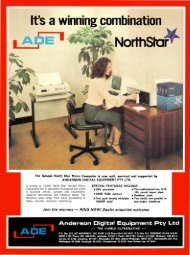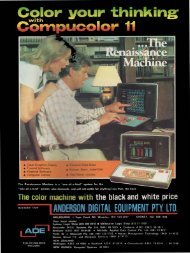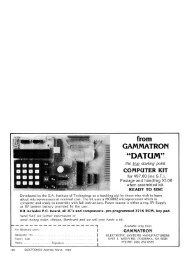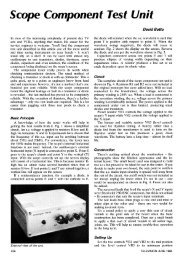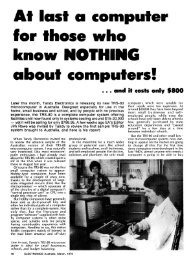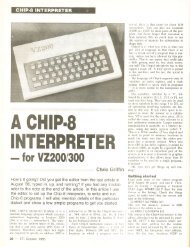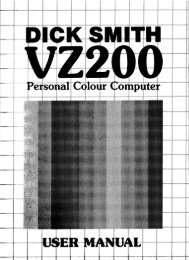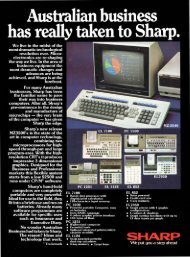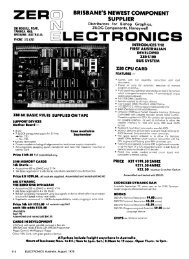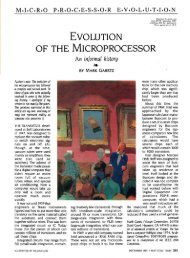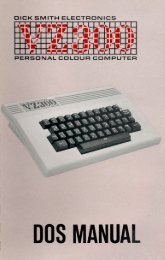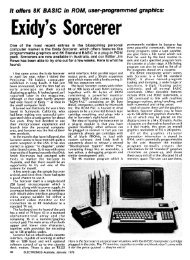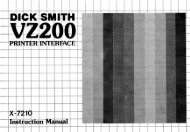The Signetics 2650 - The MESSUI Place
The Signetics 2650 - The MESSUI Place
The Signetics 2650 - The MESSUI Place
You also want an ePaper? Increase the reach of your titles
YUMPU automatically turns print PDFs into web optimized ePapers that Google loves.
<strong>2650</strong> mini assembler<br />
simplifies programming<br />
Here is a handy "real time" assembler program for small <strong>2650</strong><br />
microcomputer systems. You can use it to load programs directly<br />
into memory in mnemonic assembly language — much faster,<br />
easier and more reliable than having to do all the detailed coding<br />
and displacement calculations yourself!<br />
Programming a computer in machine<br />
language tends to be a very slow and<br />
tedious business. If you're doing it this<br />
way at the moment, you'll know what I<br />
mean. It can be challenging enough to<br />
work out the basic flow of a program -<br />
then you have to sit down and<br />
painstakingly slog through the coding,<br />
instruction by instruction.<br />
But time and tedium aren't the only<br />
problems. When you try running such a<br />
program coded by hand, the odds are<br />
that you'll find quite a few "bugs" caused<br />
by coding errors and mistakes in<br />
working out relative addressing displacements.<br />
People using larger computers<br />
generally don't need to worry about<br />
such problems, because they don't<br />
have to program in machine language.<br />
In fact many couldn't do so even if they<br />
wanted to (which is unlikely), either<br />
because they've never learned how or<br />
because the operating system on their<br />
computer has no provision for loading<br />
*G1600<br />
<strong>2650</strong> LINE ASSEMBLER<br />
by JAMIESON ROWE<br />
or running programs in this form!<br />
<strong>The</strong> closest such folk ever need to<br />
come to machine language is assembly<br />
language programming, using easy-toremember<br />
mnemonic symbols for the<br />
various instructions. An assembler<br />
program running in the computer itself<br />
is then used to translate this symbolic<br />
version of the program into machine<br />
language. <strong>The</strong> assembler takes over all<br />
the detailed coding, and works out all<br />
of those tedious displacements. Not<br />
only that, but it does them much faster<br />
and far more reliably than mere<br />
humans!<br />
Assemblers for some microcomputer<br />
systems have been available for quite a<br />
while now, giving users of these<br />
systems most if not all of the advantages<br />
possessed by larger systems. For<br />
industrial and commercial users of the<br />
<strong>2650</strong> microprocessor, <strong>Signetics</strong><br />
themselves provide a "cross assembler"<br />
— an assembler for <strong>2650</strong> code which<br />
itself runs on another machine.<br />
0440.*THIS IS A DEMONSTRATION<br />
0440.*<br />
0440.*<br />
0440. ORG 500<br />
0500. DATA 5 14<br />
0502. LODI.R3 FF SET UP R3 AS INDEX<br />
0504. LODA.R3 *+500 FETCH CHAR<br />
0507. COMI.R0 00 CHECK IF EOF (NUL)<br />
0509. BCTAJEGI el LEAVE IF FOUND<br />
050C. ZBSR *20 OTHERNISE GO PRINT<br />
050E. BCTR.UN 504 a CONTINUE<br />
0510.01 ZBSR *25 END: GIVE CRLF<br />
0512. ZBRR 22 A LEAVE—RETURN TO PIPBUG<br />
0514. ASCI "HELLO THERE!"<br />
0520. DATA 0<br />
0521. END<br />
*G500<br />
HELLO THERE!<br />
Fig. 1: A demonstration of the mini assembler in action. As you can see, a<br />
program may be run immediately following assembly.<br />
76 ELECTRONICS Australia, April, 1979<br />
For smaller <strong>2650</strong> systems, more conventional<br />
"resident" assemblers have<br />
recently become available. A limitedfacility<br />
"line" assembler called<br />
Prometheus was developed by the<br />
British Mullard company, and made<br />
available in a special ROM/RAM<br />
application card. However it was rather<br />
too expensive for hobby applications.<br />
Similarly an assembler was developed<br />
within the <strong>2650</strong> Users' Group in Sydney,<br />
but was memory-orientated and required<br />
quite a deal of RAM,memory.<br />
Neither assembler was really well suited<br />
for small hobby systems.<br />
Now for the good news. In this article,<br />
you will find details of a new <strong>2650</strong><br />
assembler which I believe is almost<br />
ideal for small hobby systems. It occupies<br />
only 1300-odd bytes, so that it<br />
should fit into almost any <strong>2650</strong> system.<br />
Yet it will let you perform convenient<br />
and fast assembly of programs, from<br />
your terminal keyboard and in real<br />
time. You type in the mnemonics; it<br />
works out the code and plugs it into<br />
memory.<br />
As you might expect, it is not a fullscale<br />
assembler like those you would<br />
find on large systems. It is basically a<br />
line assembler, which treats each instruction<br />
as a separate entity. But it<br />
does offer a very useful feature not<br />
found on many small line assemblers:<br />
limited forward referencing, which lets<br />
a branch instruction reference a<br />
memory location not yet known. This<br />
means that once you get used to its<br />
limitations, you can do almost as many<br />
things with this assembler as you can<br />
with its bigger brothers.<br />
Incidentally I can't take much of the<br />
credit for this assembler. I haven't<br />
written it from scratch, but have<br />
developed it from a small assembler<br />
called PIPLA written by the software<br />
people at <strong>Signetics</strong>. I came across PIPLA<br />
last year when I toured the <strong>Signetics</strong><br />
plant during my trip to California.<br />
<strong>The</strong> people at <strong>Signetics</strong> told me they<br />
had written PIPLA to go into a special<br />
ROM device along with a modified and<br />
enhanced version of PIPBUG. When I<br />
showed interest in it, they let me have a<br />
copy along with a source listing.<br />
I didn't have much of a chance to<br />
look closely at PIPLA during the trip<br />
but was able to do so when I came<br />
home. It didn't take long then to make<br />
a rather important discovery. Not unex-



